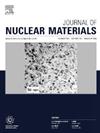Crevice corrosion behavior of 316L austenitic steel in static liquid lead-bismuth eutectic at 550°C
IF 2.8
2区 工程技术
Q3 MATERIALS SCIENCE, MULTIDISCIPLINARY
引用次数: 0
Abstract
Crevice corrosion is a significant form of localized corrosion that can lead to failures in structural components. However, there is a lack of research on this phenomenon in liquid lead-bismuth eutectic (LBE). In this study, the crevice corrosion behavior of 316 L exposed to stagnant LBE with the oxygen concentration of 1 × 10–6 wt.% at 550 °C for 500 h was examined for the first time. Microstructural characterizations indicated 316 L is susceptible to crevice corrosion and reducing the crevices size facilitates a transition from oxidation to dissolution corrosion. Grain boundaries are able to provide more diffusion channels for oxygen, thereby promoting the development of Cr-rich oxides and chemical segregations beneath the surface scale. A simplified model elucidating the transportation of dissolved oxygen within the crevice environment of LBE has been developed.

550°C 静态液态铅铋共晶中 316L 奥氏体钢的缝隙腐蚀行为
缝隙腐蚀是一种重要的局部腐蚀形式,可导致结构部件失效。然而,目前还缺乏对液态铅铋共晶(LBE)中这一现象的研究。本研究首次考察了 316 L 在氧气浓度为 1 × 10-6 wt.%、温度为 550 °C 的液态铅铋共晶中暴露 500 小时的缝隙腐蚀行为。微观结构特征表明 316 L 易受缝隙腐蚀,缩小缝隙尺寸有利于从氧化腐蚀过渡到溶解腐蚀。晶界能够为氧气提供更多的扩散通道,从而促进富含铬的氧化物和表面鳞片下化学偏析的发展。我们建立了一个简化模型,以阐明溶解氧在枸橼酸钾盐缝隙环境中的迁移情况。
本文章由计算机程序翻译,如有差异,请以英文原文为准。
求助全文
约1分钟内获得全文
求助全文
来源期刊

Journal of Nuclear Materials
工程技术-材料科学:综合
CiteScore
5.70
自引率
25.80%
发文量
601
审稿时长
63 days
期刊介绍:
The Journal of Nuclear Materials publishes high quality papers in materials research for nuclear applications, primarily fission reactors, fusion reactors, and similar environments including radiation areas of charged particle accelerators. Both original research and critical review papers covering experimental, theoretical, and computational aspects of either fundamental or applied nature are welcome.
The breadth of the field is such that a wide range of processes and properties in the field of materials science and engineering is of interest to the readership, spanning atom-scale processes, microstructures, thermodynamics, mechanical properties, physical properties, and corrosion, for example.
Topics covered by JNM
Fission reactor materials, including fuels, cladding, core structures, pressure vessels, coolant interactions with materials, moderator and control components, fission product behavior.
Materials aspects of the entire fuel cycle.
Materials aspects of the actinides and their compounds.
Performance of nuclear waste materials; materials aspects of the immobilization of wastes.
Fusion reactor materials, including first walls, blankets, insulators and magnets.
Neutron and charged particle radiation effects in materials, including defects, transmutations, microstructures, phase changes and macroscopic properties.
Interaction of plasmas, ion beams, electron beams and electromagnetic radiation with materials relevant to nuclear systems.
 求助内容:
求助内容: 应助结果提醒方式:
应助结果提醒方式:


